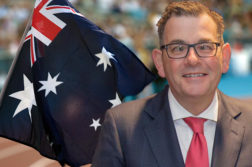The question of leadership is always a live one in any political party. For better or worse, leaders form an essential component of the modern political system. They are the key speakers for their party, the public face of policy, and the lightning rod for criticism and dissent.
But for the federal Greens, leadership is a particularly interesting dilemma, because of the distinctly federal and participatory nature of the party. A little like the Liberal Party, but in a much more grassroots fashion, the Australian Greens are a confederation of state and territory-based party organisations. There has been considerable resistance in the past to the very notion of a federal leader who would control the political wing of the environmental movement, and the Greens experience factional tensions and regional power-plays like any other party.
Under Bob Brown, these tensions were largely submerged, because of the high standing of the former leader within the party and indeed in the environment movement more generally. Brown’s personal charm is legendary inside the party, and his ability to fashion clever political alliances stood him in good stead as the Greens captured the balance of power in the Senate.
Now Brown is gone, and Christine Milne is the leader. What sort of leader will she be?
Milne is a farmer’s daughter and a former school teacher from the rural north of the state. She has an excellent reputation inside the Greens; in person she is reputed to be far warmer than her steely television personality sometimes shows. While she keeps a handsome gardening blog, no-one would claim she has quite the same popular appeal as her predecessor.
Milne won her Senate spot in 2004, despite Labor preferencing Family First ahead of the Greens in both Tasmania and Victoria (the decision that helped elect Steve Fielding to the Senate). Her high local profile helped her to a quota largely on the back of strong "below the line" voting, and she took her place alongside Brown.
As I wrote on Friday, Milne is highly experienced. She is a veteran of a decade’s worth of tough three-cornered political contests in the cauldron of Tasmanian politics, having sat in government with Labor after 1989, and then also playing kingmaker for the Liberal Party after 1996.
Milne lost her seat in 1998 after the two major parties in Tasmania tried to rig the system against the minor parties, by reducing the size of the Tasmanian Parliament to 25 members — a decision many now believe was disastrous for the state in the long-term, as it reduced the pool of backbench talent from which governments could draw upon. Ironically, it had no long-term impact on the Greens’ primary vote in the island state. Today, Greens still occupy a fifth of the seats in the Tasmanian House of Assembly, and neither major party can govern without their support.
Of course, playing a key role in deciding who governs can win as many enemies as friends. To some extent, the federal Greens have discovered this since Brown and Milne signed an agreement with Julia Gillard to support her on the floor of Parliament after the 2010 federal election. The Greens, regularly dismissed as little more than a protest party by much of the mainstream media, were suddenly in a position to help decide who ran the country. That created some powerful enemies in the business community and the right-wing media, who view the Greens’ policies on issues such as the size of Australia’s planned carbon emissions reductions with horror.
Milne will be judged on her policy and electoral achievements. In particular, she will be under pressure from her base to show that the Greens can continue to deliver pro-environment policy outcomes, and from a largely hostile political media to show she can maintain the Greens’ vote at its current historic high.
While she is an ideal candidate to manage a balance-of-power situation in the next parliament, that role may be much more muted should the Coalition win government, and perhaps even the balance of power in the Senate — consigning the Greens to parliamentary irrelevance. Can Milne cut through as the leader of a minor party in opposition? We may find out late next year.
Milne certainly has the policy nous to get some wins while Julia Gillard remains Prime Minister. Since 2010 she has repeatedly shown herself to be a tough policy negotiator, prepared to bargain hard for key victories.
The $10 billion Clean Energy Finance Corporation, for instance, is a signature Milne achievement, negotiated in the teeth of Labor hostility, particularly from players like Martin Ferguson, whose Energy department is being by-passed by the fund. For the hardheads in Treasury, so-called "complementary" measures like the clean energy fund and the renewable energy target are unnecessary now that Australia’s getting a carbon price. It was Milne’s tenacity that delivered a critical source of finance for Australia’s nascent clean-tech sector.
The CEFC has a kitty of $10 billion, and, as the Broadbent review into its operations delivered today makes clear, it will have wide discretion on how to spend it. This means that it will be able to provide loans and finance for renewables projects that have generally struggled for market support — which is pretty much everything except large-scale wind, in the current environment. It could play a crucial role in developing the next generation of clean tech export industries for Australia.
The CEFC is a good indicator of Milne’s approach to the Greens leadership. She is likely to be an innovative and creative policy thinker, an increasingly rare commodity in federal politics. Her recent remarks about Labor’s increasingly desperate surplus fetish, for instance, shows that she will be able to stand outside the political orthodoxy when it comes to economically insubstantial political shibboleths like the eternal value of a budget surplus.
Milne’s appearance on the ABC’s 7.30 last night was a case in point. Asked to explain why the Greens don’t support a surplus, she was given little chance by host Chris Uhlmann to explain her position before Uhlmann began to attack the Greens as unrealistically high taxers and spenders. "How can Australia afford what the Greens want?" he asked pointedly.
This kind of scrutiny will become more common. The onus will be on Milne and her new deputy Adam Bandt to become much more thorough with their policy costings, as well as better explainers of why they think Australia’s tax base needs to rise.
But policy milestones can quickly became millstones. A big achievement like the CEFC poses big risks for Milne — if it even survives past 2013. Because Milne has been heavily identified with the new investment fund, any failures will quickly be sheeted home.
The political difficulties that Barack Obama’s Nobel-prize winning Energy Secretary Stephen Chu has run into in the wake of the failure of Californian solar firm Solyndra is a good example. Solyndra went bust despite hundreds of millions of dollars of US government finance. It doesn’t matter that the Energy Department’s clean tech investments have been, in the main, quite successful. The failure of Solyndra has allowed the enemies of renewable energy to pillory Chu and make a devastating public case for the folly of government investment.
Milne’s enemies will be glad to do the same, should the CEFC make a similar misstep — as it almost certainly will, because the nature of investment means that there must be losers as well as winners. Just ask Peter Garrett about solar installations.
All this is speculation, of course. In the main, Milne’s party support base appears secure. Green voters can be a quarrelsome bunch, but when it comes to their voting patterns, they are remarkably stable. As Labor has drifted further right in recent decades, social progressives and committed environmentalists have found a natural home with the Greens, and they’re not going anywhere at present. With a primary vote in the low teens, the Greens can never be more than a balance-of-power party or a junior coalition partner. But neither are they going to dwindle away.
The Greens vote is essentially all base, which means that the only possible trajectory for the party is up.
Donate To New Matilda
New Matilda is a small, independent media outlet. We survive through reader contributions, and never losing a lawsuit. If you got something from this article, giving something back helps us to continue speaking truth to power. Every little bit counts.



